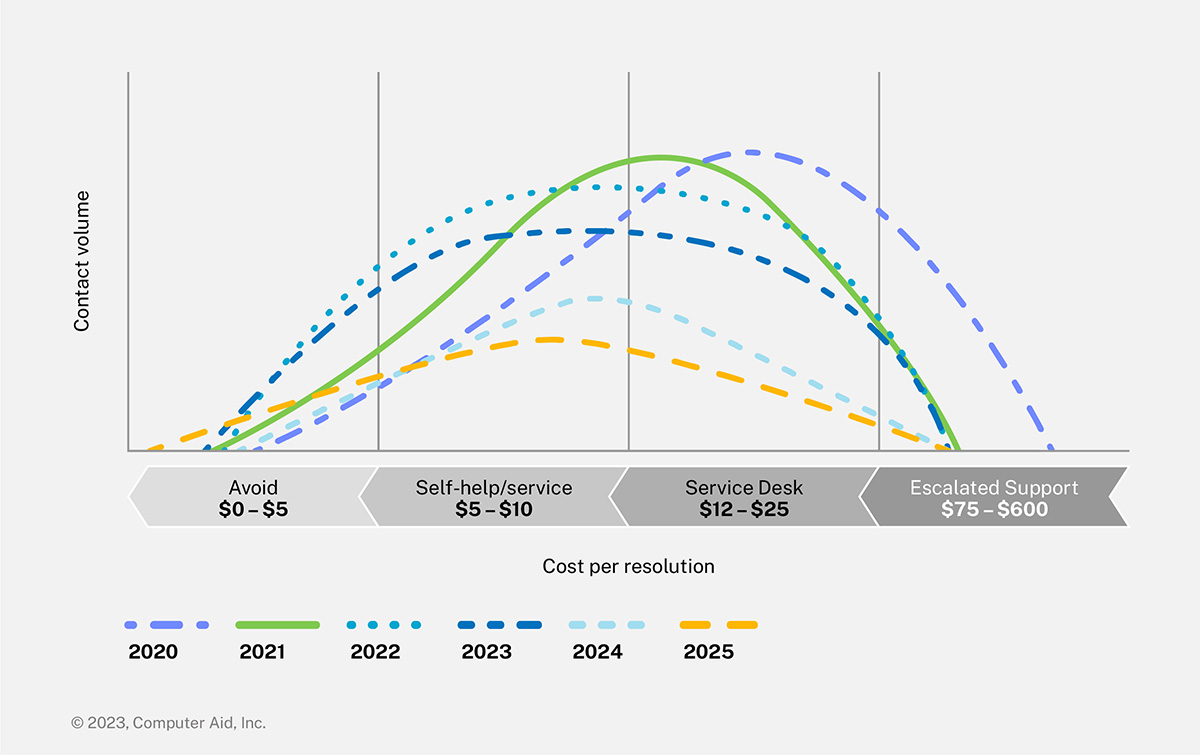A previously published article predicted a decrease in first-level resolution (FLR) and lower “agent-handled” contact volumes at IT service desks due to self-service and automation. Over the past 2 years, we have followed up on this original article, tracking the predictions against industry expert data and suggesting new ways to measure service desk performance and reap the value of automation.
The big question that arose from these findings was, “If FLR was the gold standard of measurement of service desk performance, and it is now decreasing, is service desk performance getting worse?”
Shifting left trend
The graphic below is from the original article published in 2020 (using 2019 data). The X axis is agent-handled contact volume, and the Y axis depicts the cost per resolution. Looking at the curves for the individual years, the prediction was that agent-handled contact volume would trend down with the peak resolution moving left. This likely would be due to the service desk resolving a high percentage of all contacts with lower-cost resolution tactics, such as self-service and autonomous support. This entire process is known in the industry as “shifting left.”
We anticipated some drastic drops in contact volume and FLR. So, how do the 2020 predictions hold up to 4 years’ worth of data?

By and large, industry analysts have shown these downward trends occurring as anticipated during the first 3 years of tracking. However, these trends seemed to have slowed. While this does not indicate that total agent-handled contacts per user, per year went up, as we start to see 2022 data, it could show a potential increase.
Key resolution metrics and what they indicate
Previously, we examined FLR, which is the percentage of all contacts resolved by the service desk without escalation. This is more of a financial metric than first contact resolution (FCR) because it shows the number of contacts that were resolved for the cost of one service desk contact—we are seeing an approximate cost of $20 per contact. FCR measures resolved contacts while the user is on the phone, web submissions without follow-up, or initial chat sessions. These two metrics, FLR and FCR, tend to trend together.
Expert data shows that FLR was flat from 2021 to 2022. Because this is not what was expected, it begs the question, “Exactly what is going on that is causing these trends to slow?”
The percentage of CAI client contacts using automation at the service desk has been flat. The use of automated workflows (self-service), facilitated by IT service management (ITSM), artificial intelligence (AI), and robotic process automation (RPA) tools enables IT users to help themselves. One of the primary benefits of employing automation tools is a decrease in total cost per contact—a trend we haven’t seen over the last year.
The whole concept of “shift left” is to move contact resolution from higher cost methods of resolution (from Level II and Level III) to lower cost methods of resolution (to Level I and eventually to self-service). It isn’t hard to make the connection that every contact handled through self-service (automation) is significantly more cost-effective than a contact handled by a service desk analyst—bringing down the overall cost per contact (automated contacts plus agent-handled resolutions).
The same can be said regarding customer satisfaction. While it is sometimes difficult to measure true customer satisfaction—too many factors to address in this article—logic tells us that the faster the customer gets their issue resolved and they’re back to work, the more satisfied they are. Self-service and automation help facilitate speedy resolution for many situations, and if logic holds true, could lead to increases in productivity.
One would expect the cost per agent-handled contacts would increase after ”shift left” activities because only the more difficult issues would remain to be resolved by an agent. However, the overall cost of support will come down because there are fewer contacts handled by agents.
How automation can encourage a drop in FLR
Service desk customers today like to help themselves. As the current workforce is replaced by younger people, they expect self-service and automated support. The return on investment (ROI) on service desk automations is one of the easiest to calculate and earn. (Making the case for service desk automation goes into detail, including an example calculation). In addition, automation and AI tools are coming down in price, and multiple ITSM systems include some way to automate workflows. Most large organizations have in-house skillsets, and there are many companies that offer automation services on an “as-needed” basis.
If you buy into the concept that FLR drops when automation removes the repeatable workflow issues from the service desk’s contact mix, then it begs the question: If your FLR is not currently falling, perhaps you’re not taking advantage of the technology available today? There is a definite opportunity to increase your customers’ satisfaction, bolster your organization’s efficiency and productivity, and reduce the overall cost of support through automation.
Together, let’s get the downward trends for FLR and contact volume back on track. If you would like to discuss your service desk options further, contact CAI.



